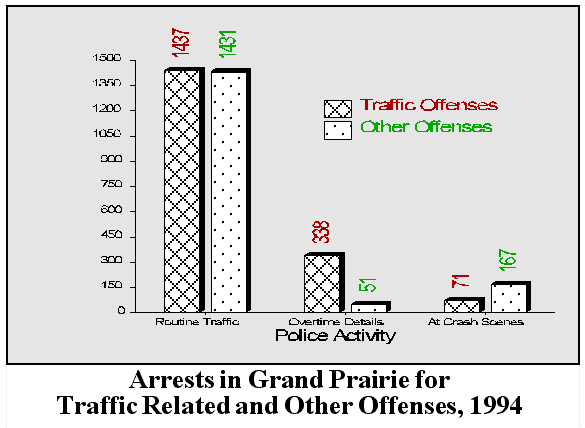















Traffic Tech #108: Traffic Enforcement Lead To Criminal Arrests Case Study Of Grand Praire, Texas, Police Department |
|---|
|

Number 108 November 1995
TRAFFIC ENFORCEMENT LEADS TO CRIMINAL ARRESTS
CASE STUDY OF GRAND PRAIRIE, TEXAS, POLICE DEPARTMENT
Routine traffic enforcement stops sometimes result in dramatic apprehension of wanted criminals. The Oklahoma Highway Patrol's arrest of Timothy McVeigh after the bombing of the Federal building in Oklahoma City is one memorable example. He was stopped while speeding in a car that did not have license plates. While there are many anecdotal accounts of incidents where traffic officers significantly contribute to crime solutions, systematic studies are rare.
The National Highway Traffic Safety Administration (NHTSA) sponsored a review of the Grand Prairie, Texas, Police Department's activities for a five year period, 1990 through 1994. Grand Prairie has a rare, if not unique, feature of their record keeping system. That feature categorizes arrests by the initiating officer activity, such as traffic enforcement, patrol, or collision investigation. When the Grand Prairie Police Department implemented their computer systems in 1985, they decided they wanted a link between the dispatch system and the records management system. The original intent was to be able to tabulate the law enforcement effort devoted to specific neighborhoods to respond to citizen inquiries.
As an element of this system, Grand Prairie police officers record codes on arrest reports to reflect the circumstances of the arrest. They record whether the arrest resulted from a dispatched call, officers' observation, or traffic enforcement stop. The system can even distinguish between arrests made by routine traffic enforcement and those made by officers working a special overtime detail. The Grand Prairie police department's capability to identify arrests made as a consequence of traffic enforcement stops is extremely unusual.
Grand Prairie has a population of about 100,000 and is located midway between Dallas and Fort Worth, Texas. There are 170 sworn officers in the police department; of which 73 are patrol officers, 3 are dedicated to traffic enforcement, and 5 to collision investigations.
Traffic Enforcement Produces 1/3 of the Arrests
During 1994, Grand Prairie police officers made 9,566 arrests. Officers on routine patrol made 2,868, or 30 percent of the total, and this has remained relatively constant over the five year period. When combined with the arrests from the special overtime traffic detail and those made at the scene of a collision, arrests from traffic enforcement account for 37 percent of the department's total.
| Table 1. Warrant and Non-Warrant Arrests in Grand Prairie, 1994 | |||
| Police Activity | Warrant | Non-Warrant Arrests | Total Arrests |
|---|---|---|---|
| Routine Traffic | 1,887 (66%) | 981 (34%) | 2,868 |
| Overtime Details | 276 (71%) | 113 (29%) | 389 |
| At Crash Scenes | 65 (27%) | 173 (63%) | 238 |
| Totals | 2,228 (64%) | 1,267 (34%) | 3,495 |
During a stop, about two thirds of the arrests were made on the basis of an outstanding warrant for a traffic related violation (like an unpaid ticket) or a more serious offense. Table 1 shows these arrests broken down by routine traffic enforcement, overtime details, or arrests at crash scenes.
The next step was to look at the kinds of arrests made by Grand Prairie traffic enforcement officers. About one half of all of their arrests were for offenses other than traffic -- offenses like burglary, robbery, violent crimes, DWI, and drugs. Interestingly, 70 percent of the arrests made at the scene of a crash were for offenses other than traffic, while most (87 percent) of the arrests made by special overtime patrols were for traffic related offenses.

Of the 47 percent of the arrests for other offenses in Grand Prairie made by traffic personnel, there were 200 arrested for assault, and almost 400 on weapons charges in the past five years. Thirty one runaway juveniles were located by traffic officers.
Importantly, on 8 separate occasions between 1990 and 1994, individuals who were wanted for murder were apprehended as a consequence of routine traffic enforcement stops by Grand Prairie officers.
The number of arrests made by Grand Prairie traffic officers provide considerable support to the contribution of routine traffic enforcement as an effective countermeasure against crime, as well as improving traffic safety. Several years ago the Chief of the Grand Prairie police department
implemented a policy requiring officers to make a computer-aided check of the license plate number of each vehicle that is stopped. Typically, an officer waits for a vehicle to pull to the side of the road before entering the plate number and location of the stop into the mobile data terminal. Usually, this information has been entered long before the wheels stop rolling on a vehicle that arouses particular suspicion.
The routine checking of license plates and driver's licenses results in identifying a large number of motorists with outstanding arrest warrants -- 64 percent in 1994 alone. The other third (36%) of the arrests made by traffic officers were made in response to officer observations and motorist actions during a stop. Weapons or contraband in a vehicle are often observed in this way.
For a copy of the 11 page report, Contributions of Traffic Enforcement to the War on Crime: Case Study of the Grand Prairie, Texas, Police Department, contact Police Traffic Services, NHTSA, NTS-41, 400 Seventh Street S.W., Washington, DC 20590, or send a fax to (202) 366-7721.
U.S. Department of Transportation
National Highway
Traffic Safety
Administration
400 Seventh Street, S.W. NTS-33
Washington, DC 20590
Traffic Tech is a publication to disseminate information about traffic safety programs, including evaluations, innovative programs, and new publications. Feel free to copy it as you wish.
If you would like to receive a copy contact:
Linda Cosgrove, Ph.D., Editor,
Evaluation Staff Traffic Safety Programs
(202) 366-2759
